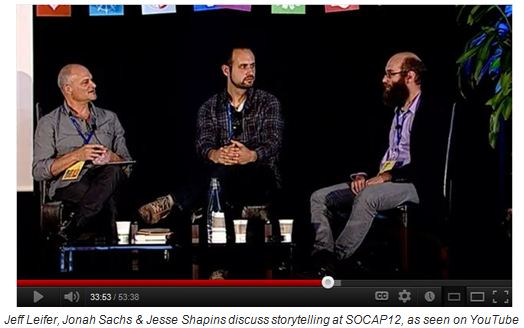Last week from October 1 – 4 San Francisco was host to Social Capital Markets 2012 (SOCAP12), an annual conference that connects global innovators, investors, foundations, institutions and social entrepreneurs in a discussion about directing the power and efficiency of market systems towards creating social good.
This year, impact investing, crowdfunding and issues facing young social enterprises were all hot topics. While you may not have been able to partake in the conference, you can still find out what was discussed, as SOCAP has shared all the presentations and panel discussions online.
We’ve been watching the presentations, and one in particular caught our eye: The New Connectivity: Storytelling for the Digital Age. In this hour long presentation and panel discussion, Jeff Leifer of Circadian Media Lab moderates a discussion about the art of storytelling between Jonah Sachs, author of Winning the Story Wars, and Jesse Shapins, co-founder and chief Strategy Architect of Zeega, a non-profit/for-profit hybrid that acts as a platform for inventing new forms of interactive storytelling.
We like how the speakers expand upon storytelling as more than just a narrative tool to frame the social good of an organization, to ultimately use storytelling as the means to connect audience to mission.
Sachs shares about the morals or values conveyed in stories, or more specifically, how your role as an organization is to “connect your audience to their deeper values.” Your story isn’t about you and the positive change your creating through your organization, it’s about motivating and empowering your audience. It’s your job “to provide hope to heal a broken world.”
Shapins makes an interesting point when he says “in the context of social change, engagement is also authored,” meaning that you can’t simply share your stories and expect people to flock to your cause. You must actively design your stories to encourage your audience to participate.
Shapins sheds light on ways to engage a society that is cluttered with information. He observes that with so much information coming at us, it’s rare that we are able to experience a moment of surprise, but that there’s value in this kind of experience. Referencing a Zeega project that profiles the more than 10,466 “Main Streets” in the US, Shapins elaborates on the opportunity in “allowing for openness and ambiguity” around a message or story to keep from falling into a standard narrative, thus allowing for the element of surprise. In doing this, you are ultimately strengthening your message or story.
So what does all of this have to do with Demonstrating Value? Your performance snapshot is your tool to communicate your value and share your story with the world. By keeping these storytelling tactics in mind when creating your snapshot – remembering that it’s not about you, but about your audience, and incorporating elements of surprise – your snapshot will be stronger, and ultimately more effective when conveying your value and impact.
The Art of Storytelling: Our Favourite Discussion from SOCAP12
blog type:
Issues & Ideas
Events
